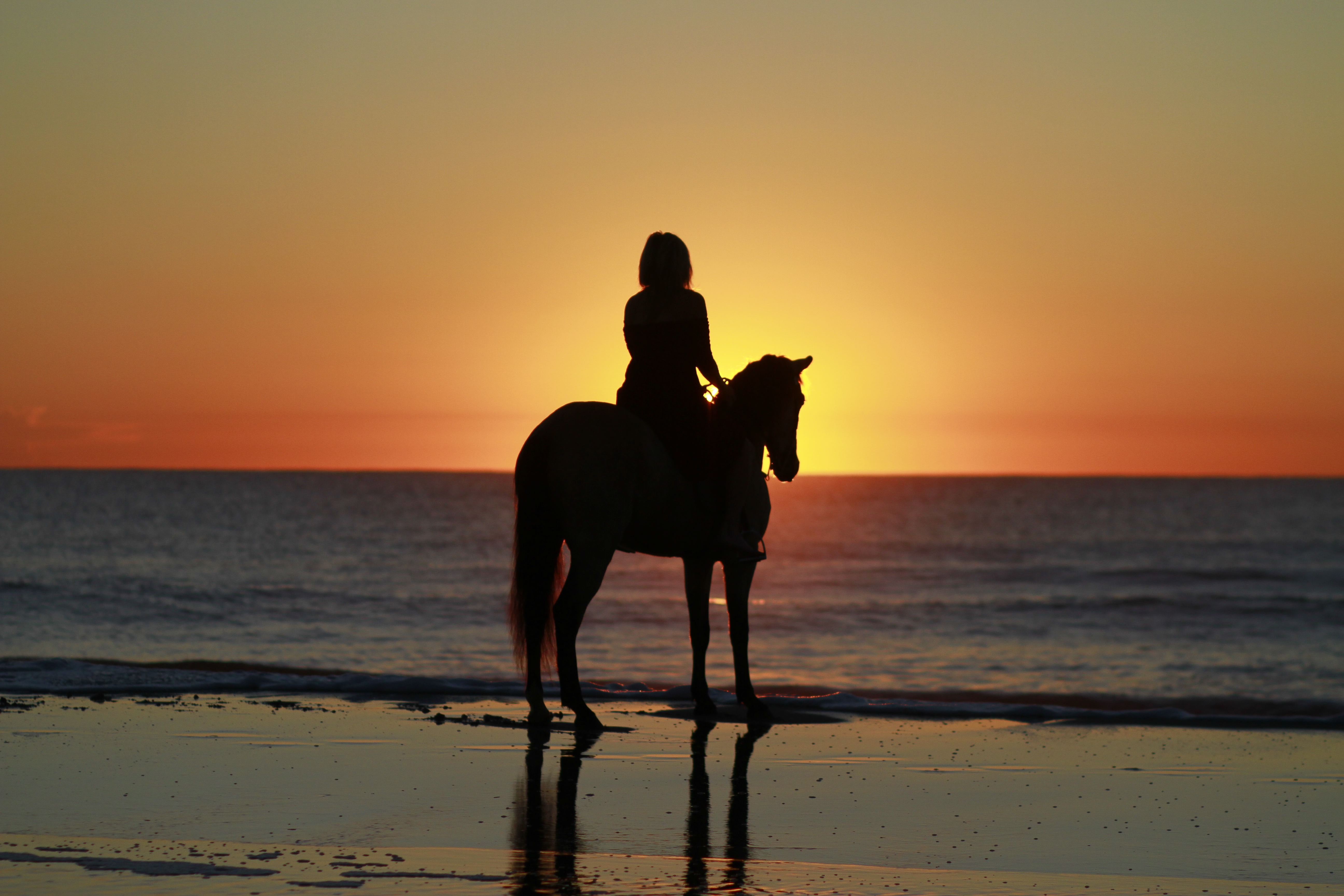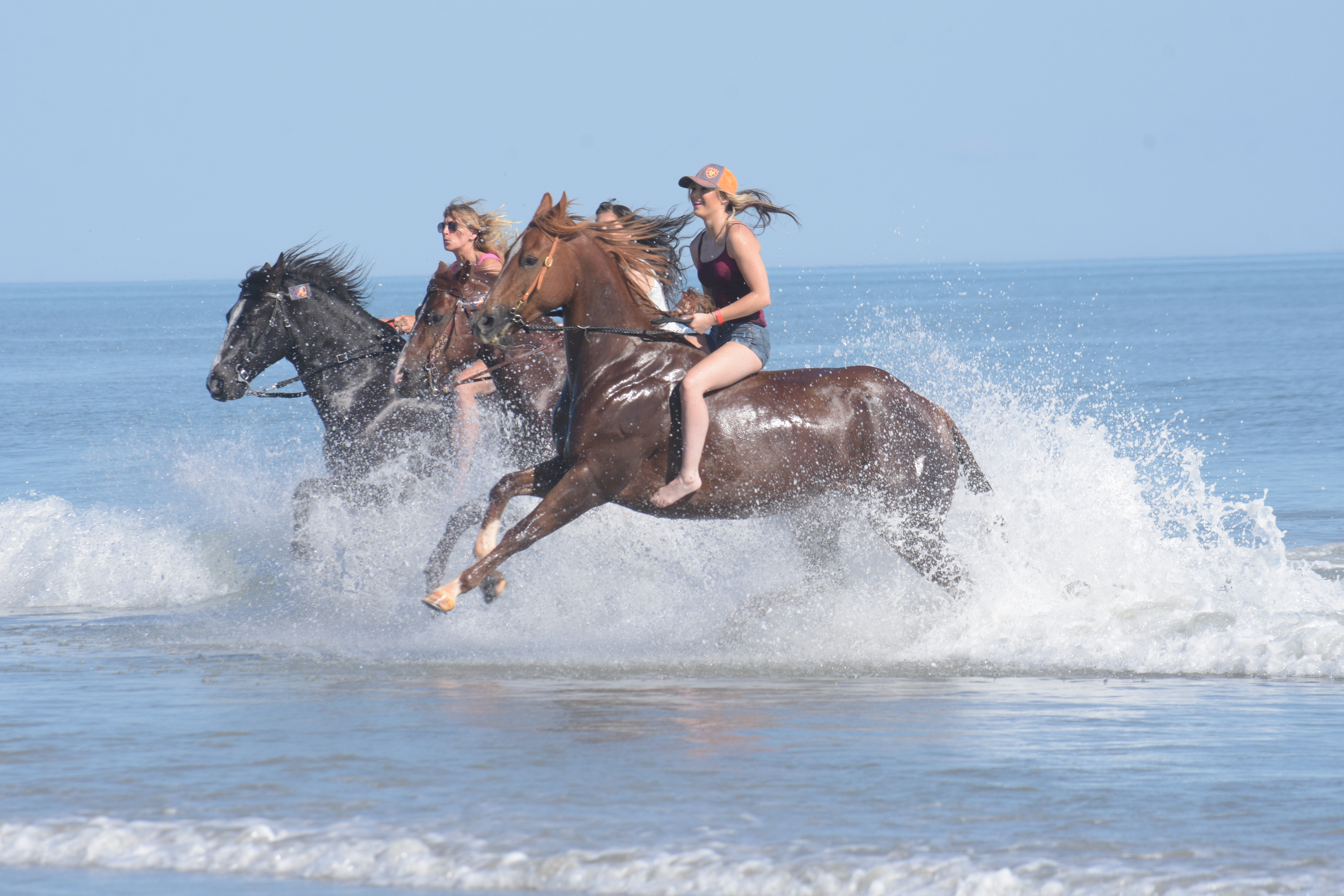“Riding on the beach can be one of life’s greatest joys, but learn how to manage the risks before you head to the surf,” says Lari Shea, an accomplished endurance rider who owns and manages Ricochet Ridge Ranch (www.horse-vacation.com), a riding-vacation destination in Fort Bragg, California, where guests routinely ride on the beach.
[READ: Riding the Oregon Coast]

If you plan to ride on the beach, follow these guidelines to help ensure that you and your horse stay safe.
Find a Buddy
For your first ride, find a riding buddy on an experienced horse that’s comfortable on the beach. Plan your first visit to coincide with a receding tide and when the water is relatively calm. High, crashing waves won’t inspire calm in a horse that has never seen the ocean!
On this initial visit, don’t try to get your horse into the water or urge him close to the waves. Let him follow the other horse and stay as far from the water as he feels comfortable. If your horse wants to approach the water, let him do so gradually.
[READ: 10 Warm Beach Rides]
Beware of the Water
Watch where you’re riding. Both horses and humans can get dizzy and feel “seasick” watching the waves’ surging motion. If you sense yourself or your horse “feeling funny,” get out of the water and onto firm sand.
“One friend, treating her top show stallion to a beach ride, had him faint underneath her when they were belly deep,” recalls Shea. “Luckily, horses float. She held his nose above water and floated him to shore. As soon as his body hit firm ground, he got up, shook himself off, and looked quite chagrined.”
Realize that a wave can easily knock your horse off his feet, particularly if it hits him broadside. If you can’t get out of the way of a wave before it reaches you, turn your horse so his rump faces the water.
Watch the Footing
Gradually condition your horse to the beach’s deep footing. “Beach footing differs depending upon sand composition and degree of moisture,” explains Shea. “Sand made up of coarse, large particles doesn’t pack well, creating deep footing whether it’s wet or dry.

“Fine-grained sand is usually firm close to the tide line,” notes Shea. “Be sure you’re on firmly packed sand before moving beyond a walk. At faster gaits, your horse catapults himself over his supporting leg like a pole vaulter, after which the elastic rebound of the muscle and tendon system snaps this leg forward. In deep footing, elastic rebound is lost, so your horse is forced to use muscle strength to pull his leg from the sand and advance it. You don’t have to worry about concussion so much as strain or sprain of tendons, muscles, or ligaments, especially if he isn’t well-conditioned.”
Some beaches have areas where sand in certain places has a “quicksand” quality. Avoid this by riding with a local who’s familiar with the area. Beyond the sand itself, keep an eye out for anything that could pose a danger. This includes submerged rocks, driftwood, seaweed/kelp, and sand shelves, which can abruptly plunge you into deep water.
[READ: 50 Great Riding Vacations]
Watch the Hooves
“Beach sand acts as sandpaper, which could wear hooves down to stubs if you ride your horse for hours every day in the sand,” says Shea.
Visit your farrier before and after a beach riding vacation. If your horse wears pads, use a silicone packing (or a combination of pine tar and oakum) between the pad and the sole to prevent sand from collecting there. Or, cut a cross or circle in the pad’s middle to allow sand to exit.
Take it Easy
Be aware that riding in beach sand can be very tiring to your horse. If he’s fit for an hour’s ride in a sand arena, he should handle an easy beach ride with no problems. But tempting as it may be to charge down the surf in an all-out gallop, don’t do it! Horses tire much more easily in beach sand, because their muscles literally have to pull each leg out of the sand with every stride.

“Most horses are exhilarated on the beach,” cautions Shea. “The unique environment, the fresh air, the crashing waves excite them. Horses will often get caught up in the adventure and want to go further and faster, so the rider needs to be the brains.
“On my riding vacations, we canter for about five miles on the beach, but we periodically break to a walk during this time. Also, you don’t want to always run when you go to the beach, because then your horse will think he’s always supposed to run there.”
Shea recommends starting at a steady trot, then moving into an easy canter or lope. She emphasizes the importance of control, especially when loping in a group. There should always be a lead horse — one that’s easy to control. Make an agreement that if any other horse gets going so fast that he passes this lead horse, every rider in the group will pull their horse down to a walk.
“Check to make sure you still have ‘brakes’ by frequently asking your horse to come back to you, slowing his pace or shortening his stride,” Shea adds. “In the beach’s wide-open spaces, your horse may want to accelerate. So keep your head, and keep him under control. Go back to a slower gait while your horse still has something left in the tank.”
Prepare for a Spook
“From waves and seaweed, to driftwood, dogs, and kites, there’s plenty to spook your horse at the shore,” says Shea. “These beach bogey-men are best met in the company of a calm, experienced companion. Your horse will gradually acclimate to the beach environment, but he’s always going to be more alert than usual.
“Wind on the beach is often strong, so make sure your helmet fits and is well-fastened,” Shea adds. “If you’re riding in a baseball cap or cowboy hat, use stampede strings so your hat doesn’t blow off and spook the horse behind you. This also applies to any scarf, shirt, or jacket tied around your waist or anything that can come loose.”
Be Courteous to Beachgoers
Communicate with and be courteous to those you meet on the beach, especially since most of them won’t be familiar with horses. If you encounter sunbathers or people walking, don’t ride between them and the water. Instead go inland of them. This way if a wave — or anything else — startles your horse, he won’t spook toward the people.

If you’re in a group of horses, stay together as you ride past. Don’t surround the people, as this can be intimidating. Should you find yourself in a narrow section of beach where dunes or cliffs prevent you from riding inland to pass people, announce yourself, and ask to pass. Always pass people at a walk.
If you’re approaching people who have their backs to you, call out so you don’t surprise them. They may not hear your horse over the waves. If people are playing Frisbee or flying kites, and you’re afraid their activity may frighten your horse, ask them to cease the activity until you’re safely past.
Respect the Environment
“All over the United States, horse-people have lost access to beaches,” Shea notes. “Much of that is due to safety concerns for humans on the beach. But even if it’s a deserted beach, horses can damage flora and fauna. “It’s important for horsemen to be aware of this and to be good stewards of the environment where they ride.”
If you spot any type of marine life, stay away. If you’re worried there may be a problem — say, you see a baby seal by itself — report it to beach-control personnel or a wildlife specialist. Don’t try to intervene. Don’t ride through flocks of sea birds. Go inland to skirt around them. Avoid riding near any posted areas where there may be bird or turtle nests/eggs.
Swim with Care
Swimming in the ocean with your horse may be the ultimate beach experience, but gradually introduce your horse to deep water, and choose a warm day when the surf is calm. Don’t use any type of tie-down or standing martingale, or your horse can drown. For safety, Shea recommends going bareback and barefoot, as soaked saddles and boots can weigh down you and your horse.
“First, keep close to the shallows in firm sand footing, letting your horse get used to waves slapping against his legs and then belly,” says Shea. “Practice riding parallel to the beach, in both directions, to acclimate both of your horse’s eyes to the ocean-side and land-side views. Also practice riding both into and out of the surf at right angles to the beach, so your horse knows which way to head for dry land.”
When your horse is in belly-deep water parallel to shore, there will come a moment when the next wave floats him. Steer him toward shore, so just a few paddles will get him back onto firm footing. If he seems to enjoy the experience, take another diagonal track back into deeper water, letting him swim for 15 to 20 seconds. Be careful not to let back-flow carry your swimming horse farther away from shore.
[READ: Trail Riding in Hawaii]

Stay on the top of or beside your swimming horse, floating above him holding his mane to stay connected. Don’t get in front of or under him, because a paddling hoof can quite easily break your leg. Never use the reins as a tow rope. Keep most of the slack out, and be careful not to let them wind around your wrist or any part of your body.
Be aware that in the ocean, the wave action will tire out a horse in just 2 to 10 minutes.
Post-Ride Cleanup
Salt is drying, and sand is gritty, so you’ll need to be extra-diligent with a post-ride cleanup after your beach outing.
Start by thoroughly rinsing your horse’s coat. If you find any scrapes or abrasions, clean and treat them with antiseptic to help prevent infection, as sand and sea water can harbor bacteria. Hose down all your tack, including protective leg boots if you use them. Apply leather conditioner to prevent drying or cracking. If you regularly ride on the beach, you may want to invest in BioThane or nylon tack, since it can take the abuse better than leather equipment.
Cynthia McFarland is a seasoned trail rider and full-time freelance writer based in Central Florida. She regularly contributes to national equine magazines and is the author of eight books.

